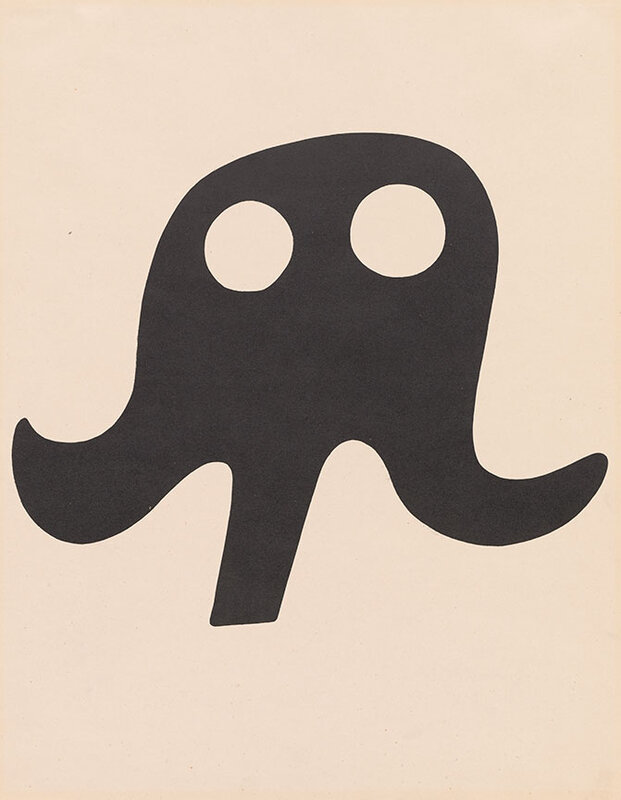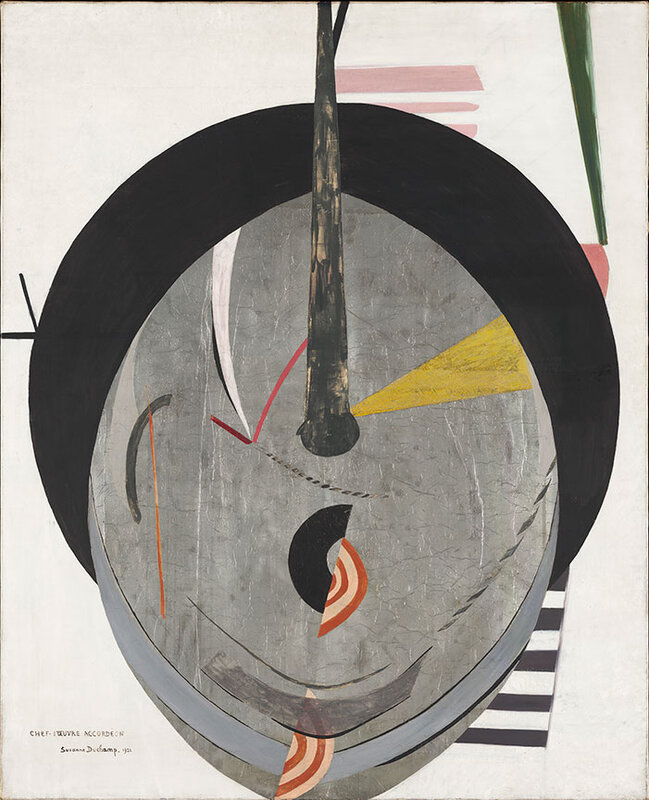February 12–July 3 2016
Exhibition celebrates contemporary influence of revolutionary movement with Dada-inspired installation, design, performances, and programs
The Yale University Art Gallery salutes the centennial of the birth of Dada with the special exhibition Everything Is Dada, which presents major paintings, sculptures, drawings, prints, and photographs from the Gallery’s collection by Jean (Hans) Arp, Marcel Duchamp, George Grosz, Francis Picabia, Man Ray, Kurt Schwitters, Sophie Taeuber-Arp, Beatrice Wood, and many others. The exhibition features a Dada-inspired installation and a dynamic series of programs that highlight the provocative and performative aspects of this avant-garde movement.
Exhibition Overview
In 1916 a group of young men and women from across Europe came together in Zurich and shook the foundations of the art world. At the Cabaret Voltaire, they staged innovative and often shocking shows that included dance, music, poetry, and puppetry, laying the ground for postmodern performance art. Firmly anti-authoritarian, the Dada artists questioned established norms and academic traditions and created works that blurred the line between fine and applied arts. They rejected the idea that an object needed aesthetic value to be considered art, and they claimed that everyone could be an artist. Dadaists incorporated everyday objects—such as newspapers, mechanical parts, lightbulbs, and other random items—into their works to capture the zeitgeist. They also experimented with new techniques such as collage and assemblage and invoked the element of chance in the creative process.
Dada was insolubly linked to the events of its time; indeed, many of the artists, such as Grosz and Picabia, expressed in their works the irony and absurdity they saw during and after World War I. Subsequently, when the artists left Zurich—which had served as a safe haven in neutral Switzerland during the war—to return to their home countries or move abroad, Dadaist ideas spread to other cities. Dada evolved significantly in Berlin, Hanover, Cologne, and Paris. New York was another incubator of Dada ideas, and the work of American and European artists there, such as Duchamp and Man Ray, was infused with a similar irreverent approach to artistic traditions.
Although Dada took on very different shapes over the years, circulating geographically and evolving into other movements, all of its artists shared an enthusiasm for provocation and a desire to break free from the moral, political, and aesthetic dogmas of the time. With their mockery of elitism and tradition, their use of mass media and popular culture, and their experimental methods, Dada artists challenged the concept of what constitutes a work of art, setting the stage for many later avant-garde movements including Surrealism, Pop art, and Conceptual art.
Frauke V. Josenhans, the Horace W. Goldsmith Assistant Curator of Modern and Contemporary Art and curator of Everything Is Dada, explains that “rather than giving a single definition or a historical survey, this exhibition investigates Dada’s irreverent, humorous, and unconventional approach. It illustrates how, 100 years after its birth, Dada’s impact on art can still be felt today. Indeed, many contemporary artists claim figures such as Kurt Schwitters as a source of inspiration.”
Fostering dialogue between the original works of art and the gallery environment, Everything Is Dada includes Dada-inspired interactive elements and a specially designed gallery space conceived in collaboration with Christopher Sleboda, Director of Graphic Design, and students from the Yale School of Art Graphic Design program. This space features a “Dada lounge,” where visitors can listen to original Dada sound poetry, a revolutionary literary form with seemingly nonsensical content that uses language broken down into abstract parts and phonetic sounds. In addition, a selection of seven Dada and Surrealist short films—including works by Hans Richter, Man Ray, René Clair, Fernand Léger, and Charles Sheeler—are screened in an adjacent gallery.
Dada sparked a creative revolution in the performing arts that continues to be relevant today. In celebration of the experimental and provocative spirit of Dada, a series of performances and programs throughout the run of the exhibition incorporates dance, music, gallery talks, lectures, and even a Dada ball. Together the programs comprise an “un-symposium,” a fittingly non-traditional format for exploring the irreverent aspects of the Dada movement.
Pamela Franks, the Seymour H. Knox, Jr., Curator of Modern and Contemporary Art and Deputy Director for Exhibitions, Programming, and Education, explains, “Everything Is Dada draws on one of the cornerstones of the Gallery’s holdings of modern art—the Société Anonyme Collection, which was given to Yale in 1941 by the collection’s founders, Katherine Dreier and Marcel Duchamp. The Société Anonyme Collection includes major works by influential Dadaists—including Marcel Duchamp, Suzanne Duchamp, Angelika Hoerle, Francis Picabia, Man Ray, and Kurt Schwitters—that comprise the heart of the exhibition. The spirit of Dada is reflected in the extraordinary collaborations involved in the exhibition’s design, installation, and ‘un-symposium.’ Partnerships with the Yale School of Art, Yale Dance Theater, and the Yale student music ensemble Black Is the Color create dynamic exchanges that are only possible at a university where creativity permeates the campus atmosphere.”
On View
February 12–July 3, 2016
Related Programs
Dada Un-Symposium
The following programs, which are part of the Dada Un-Symposium, are generously sponsored by the Lydia Winston Malbin Fund. The Dada Un-Symposium is organized by Molleen Theodore, Assistant Curator of Programs, Yale University Art Gallery.
Gallery Talks
Wednesday, February 17, 12:30 pm
“Everything Is Dada: 100 Years of Art and Anti-Art”
Frauke V. Josenhans, the Horace W. Goldsmith Assistant Curator of Modern and Contemporary Art, Yale University Art Gallery
Wednesday, March 30, 12:30 pm
“Checkmate: Dada Interventions in Art”
Dorothea Dietrich, B.A. 1976, M.A. 1978, PH.D. 1986
Wednesday, April 27, 12:30 pm
“Dadaists Painting with Scissors, Adhesives, Plaster, Paper … ”
Frauke V. Josenhans and Cynthia Schwarz, Assistant Conservator of Paintings, Yale University Art Gallery
Featured Program
Thursday, February 25, 5:30 pm
Dada Ball
Dadaists used paper, cardboard, and rugs to create costumes for their performances—which included poetry readings and dance pieces—at the Cabaret Voltaire in Zurich. Perishable, deliberately ugly, and absurd, the outfits symbolized the artists’ anti-authoritarian spirit and their claim that “everything is Dada.” This ball fully embraces Dada’s assault on good taste and celebrates it with an evening of music, poetry, photography, refreshments, and more. Dada-inspired costumes are encouraged.
Lecture
Thursday, March 3, 5:30 pm
“RoseLee Goldberg on Dada and Dance”
RoseLee Goldberg, Founder and Director of Performa
Cosponsored by Yale Dance Theater, Dance Studies Curriculum, and the Theater Studies Program.
Performances
Saturday, April 2, 12:30–3:30 pm
Open Rehearsal, “Yale Dance Theater: Gaga/Dada”
Sunday, April 3, 2:00 pm
“Yale Dance Theater: Gaga/Dada”
Yale Dance Theater (YDT) and the Gallery have invited artists Saar Harari and Lee Sher to create a new choreographic work for YDT dancers that incorporates Gaga, a movement language developed by choreographer Ohad Naharin. Gaga, which has become highly influential in international contemporary dance, is the focus of YDT’s spring semester project. On Saturday, April 2, YDT students have an open rehearsal within the exhibition Everything Is Dada. On Sunday, April 3, they perform the new piece in the space, juxtaposing the 21st-century Gaga aesthetic with Dada works of art. Cosponsored by Yale Dance Theater, Dance Studies Curriculum, and the Theater Studies Program.
Gallery+
Thursday, April 7, 5:30 pm
Gallery+Black Is the Color: With Hidden Noise
Black Is the Color, a music group made up of Gideon Broshy, CC ’17; Dominic Coles, CC ’16; Hans Bilger, BR ’16; Eli Brown, ES ’17; and Adrian Lin, JE ’18, presents a performance installation crafted with structured improvisation. In With Hidden Noise, a work designed for the exhibition Everything Is Dada, musicians scattered throughout the galleries communicate solely through sound. Together they build textures—warm ambient sound, noise, and silence—that serve as a sonic architecture through which visitors move. The Gallery is a physical and aural playground for the piece, and the works of art on view offer conceptual, aesthetic, and political points of resonance. Gallery+ is an ongoing series of collaborations that invites students to respond to the Gallery’s collection through special programs and performances.
All programs are free and open to the public unless otherwise noted. For more detailed programming information, visit artgallery.yale.edu/programs
Exhibition organized by Frauke V. Josenhans, the Horace W. Goldsmith Assistant Curator of Modern and Contemporary Art, Yale University Art Gallery. Made possible by the Société Anonyme Endowment Fund.

